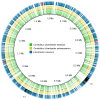Comparative genomics of cultured and uncultured strains suggests genes essential for free-living growth of Liberibacter
- PMID: 24416233
- PMCID: PMC3885570
- DOI: 10.1371/journal.pone.0084469
Comparative genomics of cultured and uncultured strains suggests genes essential for free-living growth of Liberibacter
Abstract
The full genomes of two uncultured plant pathogenic Liberibacter, Ca. Liberibacter asiaticus and Ca. Liberibacter solanacearum, are publicly available. Recently, the larger genome of a closely related cultured strain, Liberibacter crescens BT-1, was described. To gain insights into our current inability to culture most Liberibacter, a comparative genomics analysis was done based on the RAST, KEGG, and manual annotations of these three organisms. In addition, pathogenicity genes were examined in all three bacteria. Key deficiencies were identified in Ca. L. asiaticus and Ca. L. solanacearum that might suggest why these organisms have not yet been cultured. Over 100 genes involved in amino acid and vitamin synthesis were annotated exclusively in L. crescens BT-1. However, none of these deficiencies are limiting in the rich media used to date. Other genes exclusive to L. crescens BT-1 include those involved in cell division, the stringent response regulatory pathway, and multiple two component regulatory systems. These results indicate that L. crescens is capable of growth under a much wider range of conditions than the uncultured Liberibacter strains. No outstanding differences were noted in pathogenicity-associated systems, suggesting that L. crescens BT-1 may be a plant pathogen on an as yet unidentified host.
Conflict of interest statement
Figures



Similar articles
-
Growth Dynamics and Survival of Liberibacter crescens BT-1, an Important Model Organism for the Citrus Huanglongbing Pathogen "Candidatus Liberibacter asiaticus".Appl Environ Microbiol. 2019 Oct 16;85(21):e01656-19. doi: 10.1128/AEM.01656-19. Print 2019 Nov 1. Appl Environ Microbiol. 2019. PMID: 31420343 Free PMC article.
-
Growth parameters of Liberibacter crescens suggest ammonium and phosphate as essential molecules in the Liberibacter-plant host interface.BMC Microbiol. 2019 Oct 12;19(1):222. doi: 10.1186/s12866-019-1599-z. BMC Microbiol. 2019. PMID: 31606047 Free PMC article.
-
Concomitant Loss of the Glyoxalase System and Glycolysis Makes the Uncultured Pathogen "Candidatus Liberibacter asiaticus" an Energy Scavenger.Appl Environ Microbiol. 2017 Nov 16;83(23):e01670-17. doi: 10.1128/AEM.01670-17. Print 2017 Dec 1. Appl Environ Microbiol. 2017. PMID: 28939611 Free PMC article.
-
Progress and Obstacles in Culturing 'Candidatus Liberibacter asiaticus', the Bacterium Associated with Huanglongbing.Phytopathology. 2019 Jul;109(7):1092-1101. doi: 10.1094/PHYTO-02-19-0051-RVW. Epub 2019 Jun 3. Phytopathology. 2019. PMID: 30998129 Review.
-
Understanding the Physiology of Liberibacter asiaticus: An Overview of the Demonstrated Molecular Mechanisms.J Mol Microbiol Biotechnol. 2018;28(3):116-127. doi: 10.1159/000492386. Epub 2018 Sep 3. J Mol Microbiol Biotechnol. 2018. PMID: 30176677 Review.
Cited by
-
The Microbial Connection to Sustainable Agriculture.Plants (Basel). 2023 Jun 14;12(12):2307. doi: 10.3390/plants12122307. Plants (Basel). 2023. PMID: 37375932 Free PMC article. Review.
-
Comprehensive meta-analysis, co-expression, and miRNA nested network analysis identifies gene candidates in citrus against Huanglongbing disease.BMC Plant Biol. 2015 Jul 28;15:184. doi: 10.1186/s12870-015-0568-4. BMC Plant Biol. 2015. PMID: 26215595 Free PMC article.
-
Growth Dynamics and Survival of Liberibacter crescens BT-1, an Important Model Organism for the Citrus Huanglongbing Pathogen "Candidatus Liberibacter asiaticus".Appl Environ Microbiol. 2019 Oct 16;85(21):e01656-19. doi: 10.1128/AEM.01656-19. Print 2019 Nov 1. Appl Environ Microbiol. 2019. PMID: 31420343 Free PMC article.
-
Interactions of Liberibacter Species with Their Psyllid Vectors: Molecular, Biological and Behavioural Mechanisms.Int J Mol Sci. 2022 Apr 5;23(7):4029. doi: 10.3390/ijms23074029. Int J Mol Sci. 2022. PMID: 35409386 Free PMC article. Review.
-
Growth parameters of Liberibacter crescens suggest ammonium and phosphate as essential molecules in the Liberibacter-plant host interface.BMC Microbiol. 2019 Oct 12;19(1):222. doi: 10.1186/s12866-019-1599-z. BMC Microbiol. 2019. PMID: 31606047 Free PMC article.
References
-
- Raddadi N, Gonella E, Camerota C, Pizzinat A, Tedeschi R, et al. (2011) ‘Candidatus Liberibacter europaeus’ sp nov that is associated with and transmitted by the psyllid Cacopsylla pyri apparently behaves as an endophyte rather than a pathogen. Environ Microbiol 13: 414–426. - PubMed
-
- Jagoueix S, Bove J, Garnier M (1994) The phloem-limited bacterium of greening disease of citrus is a member of the α subdivision of the proteobacteria. Internat J System Bacteriol 44: 379–386. - PubMed
-
- Teixeira D, Saillard C, Eveillard S, Danet JL, Inacio da Costa P, et al. (2005) ‘Candidatus Liberibacter americanus’, associated with citrus Huanglongbing (greening disease) in Sao Paulo State, Brazil. Internat J System Environ Microbiol 55: 1857–1862. - PubMed
-
- Secor GA, Rivera VV, Abad JA, Lee I-M, Clover GRG, et al. (2009) Association of ‘Candidatus Liberibacter solanacearum’ with zebra chip disease of potato established by graft and psyllid transmission, electron microscopy, and PCR. Plant Dis 93: 574–583. - PubMed
Publication types
MeSH terms
Substances
LinkOut - more resources
Full Text Sources
Other Literature Sources
Molecular Biology Databases

